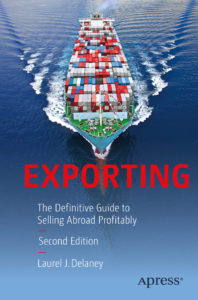Are You Ready to Export?
by Laurel J. Delaney
Anyone who wants to export, can. The world awaits. The essential element needed to be successful exporting is readiness. The rest is mechanics and know-how. Whether you’re a first-time exporter or entering a new market, selling goods and services across borders is easy and just a mouse click away. I’m here to show you how. But before I get to that, let me take you back to a little more than twenty-five years ago.
It was 1985. Even back then, I challenged conventional assumptions about how to compete and started to view markets outside the United States as the future of the business I had started: Global TradeSource, Ltd. I even put “global,” “trade,” and “source” in the company name, thereby shifting the buyer’s possibilities from being local to those of the world and drawing upon the distinctive strengths of alternative, growing overseas markets as those that would offer the company’s products and services.
That kind of vision, along with a more recent facilitator called the Internet, has broken down every imaginable barrier to growth and prosperity and has transformed not just how we conduct business but the world at large. The moment you create a Web site, blog, or Facebook account, your point of contact with consumers becomes global. The Internet is the great global leveler and gives everyone a chance to make spectacular strides in exporting—by finding, acquiring, and servicing customers the world over faster than ever—which in turn drives profits and growth for businesses. The blueprint for prosperity in exports is right at your fingertips. Never has there been such attention to the Internet, interconnectedness, and exporting than now.
“Note: The Internet has broken down all barriers to world commerce. It is your most potent weapon in the battle to capture more international sales.” — Laurel J. Delaney
The use of technology, especially social networks such as Facebook, LinkedIn, and Twitter, along with the advent of smart phones and tablets, makes finding and exporting opportunities in the world marketplace a breeze for small business owners and executives. And as a result of these incredible advancements in technology, these same empowered individuals can create opportunities on the web—not just browse for themselves—and even launch whole new enterprises in a heartbeat based on unmet needs and interests expressed by consumers.
Because social networks enable us to extend our worldwide connections rapidly, increasing our ability to identify opportunities on a more open, transparent basis, none of us operates in a vacuum as a solo entrepreneur any longer.
What does this have to do with exporting and your readiness to do so? Plenty. It defines how an export business is born and can grow, if nurtured correctly, into something absolutely amazing.
Next, let’s take a look at a three examples of real-world situations that could arise that will shape how you view the potential of exporting and how it gets done. After that, we’ll move on to what it takes to succeed in exporting. Last, we’ll make a distinction between exporting services and products—which will allow you to decide what you are going into the international market with.
You’ll note that at this point I do not talk about the financial considerations of exporting. They are obviously an important aspect that you must consider before you export in order to be properly capitalized. However, I am intentionally leaving the discussion out of this section because it will be covered later.
To learn more … buy the book.
©2019 Laurel J. Delaney. All rights reserved.
The above is an excerpt from Laurel Delaney’s book, “Exporting: The Definitive Guide to Selling Abroad Profitably,” published by Apress (2016).




 There are more than 8 billion potential customers in the world looking for your product or service. Are you ready to serve them?
There are more than 8 billion potential customers in the world looking for your product or service. Are you ready to serve them?